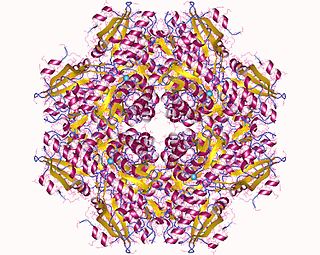
Muconate lactonizing enzymes are involved in the breakdown of lignin-derived aromatics, catechol and protocatechuate, to citric acid cycle intermediates as a part of the β-ketoadipate pathway in soil microbes. Some bacterial species are also capable of dehalogenating chloroaromatic compounds by the action of chloromuconate lactonizing enzymes. MLEs consist of several strands which have variable reaction favorable parts therefore the configuration of the strands affect its ability to accept protons. The bacterial MLEs belong to the enolase superfamily, several structures from which are known. MLEs have an identifying structure made up of two proteins and two Magnesium ions as well as various classes depending on whether it is bacterial or eukaryotic. The reaction mechanism that MLEs undergo are the reverse of beta-elimination in which the enolate alpha-carbon is protonated. MLEs can undergo mutations caused by a deletion of catB structural genes which can cause some bacteria to lose its functions such as the ability to grow. Additional mutations to MLEs can cause its structure and function to alter and could cause the conformation to change therefore making it an inactive enzyme that is unable to bind its substrate. There is another enzyme called Mandelate Racemase that is very similar to MLEs in the structural way as well as them both being a part of the enolase superfamily. They both have the same end product even though they undergo different chemical reactions in order to reach the end product.
Carboxy-lyases, also known as decarboxylases, are carbon–carbon lyases that add or remove a carboxyl group from organic compounds. These enzymes catalyze the decarboxylation of amino acids, beta-keto acids and alpha-keto acids.
In enzymology, a 3-carboxy-cis,cis-muconate cycloisomerase is an enzyme that catalyzes the chemical reaction
In enzymology, a carboxy-cis,cis-muconate cyclase is an enzyme that catalyzes the chemical reaction

In enzymology, a chloromuconate cycloisomerase is an enzyme that catalyzes the chemical reaction
In enzymology, a muconolactone Δ-isomerase is an enzyme that catalyzes the chemical reaction
The enzyme 3-hydroxy-2-methylpyridine-4,5-dicarboxylate 4-decarboxylase (EC 4.1.1.51) catalyzes the chemical reaction
The enzyme 4,5-dihydroxyphthalate decarboxylase (EC 4.1.1.55) catalyzes the chemical reaction
The enzyme 4-hydroxyphenylacetate decarboxylase (EC 4.1.1.83) catalyzes the chemical reaction
The enzyme 5-guanidino-2-oxopentanoate decarboxylase (EC 4.1.1.75) catalyzes the chemical reaction

The enzyme aminocarboxymuconate-semialdehyde decarboxylase (EC 4.1.1.45) catalyzes the chemical reaction

In enzymology, an aspartate 4-decarboxylase (EC 4.1.1.12) is an enzyme that catalyzes the chemical reaction
The enzyme carnitine decarboxylase (EC 4.1.1.42) catalyzes the chemical reaction

Diphosphomevalonate decarboxylase (EC 4.1.1.33), most commonly referred to in scientific literature as mevalonate diphosphate decarboxylase, is an enzyme that catalyzes the chemical reaction
The enzyme gentisate decarboxylase (EC 4.1.1.62) catalyzes the chemical reaction
The enzyme o-pyrocatechuate decarboxylase (EC 4.1.1.46) catalyzes the chemical reaction
The enzyme phenylpyruvate decarboxylase (EC 4.1.1.43) catalyzes the chemical reaction
The enzyme protocatechuate decarboxylase (EC 4.1.1.63) catalyzes the chemical reaction

The enzyme 3-oxoadipate enol-lactonase (EC 3.1.1.24) catalyzes the reaction

3-Carboxy-cis,cis-muconic acid is a metabolite of the catechin degradation by Bradyrhizobium japonicum.







